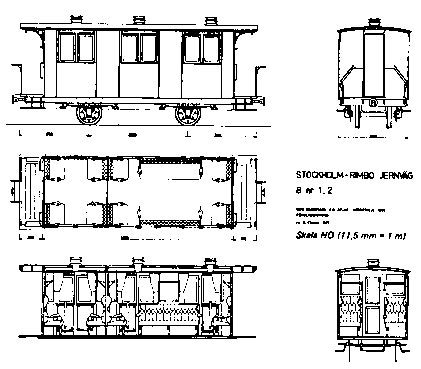





|
Nr |
Built |
Class |
Rebuilt into, year |
Seats 1913† |
Weight [kg] 1913† |
With- |
Scrap |
Notes |
|
1 |
1885 |
B |
C 1910 |
16 |
6350 |
1925 |
same yr |
Reclassified only, not rebuilt. |
|
2 |
1885 |
B |
CD 1909 |
3 |
6200 |
1940 |
same yr |
May have been class BD for a brief period. Two comparments rebuilt to post comparment, one second class compartment kept.‡ |
|
3 |
1885 |
BC |
C 1909 |
25 |
5850 |
1926 |
same yr |
Reclassified only, not rebuilt. |
|
4 |
1885 |
BC |
C 1909 |
25 |
5850 |
1926 |
same yr |
Reclassified only, not rebuilt. |
|
5 |
1885 |
C |
CD bef 1913 |
20 |
5750 |
1930 |
same yr |
One third class compartment rebuilt to post compartment‡ |
|
6 |
1885 |
C |
CD bef 1913 |
7 |
6100 |
1940 |
no info |
Three third class compatments rebuilt to post compartment‡ |
|
7 |
1885 |
C |
CD bef 1913 |
20 |
5750 |
1940 |
same yr |
One third class compartment rebuilt to post compartment‡ |
|
8 |
1885 |
C |
|
31 |
5350 |
1933 |
no info |
|
|
9 |
1885 |
C |
|
31 |
5350 |
1939 |
preserv SRJmf |
1964 SJ maintenance car 606413 Stockholm |
|
10 |
1885 |
C |
|
31 |
5350 |
no info |
1963 |
|
|
11 |
1886 |
B |
C 1910 |
20 |
5900 |
no info |
no info |
Reclassified only, not rebuilt |
|
12 |
1886 |
B |
C 1910 |
20 |
5900 |
1926 |
no info |
Reclassified only, not rebuilt |
|
13 |
1886 |
C |
|
30 |
5800 |
no info |
1966 |
|
|
14 |
1886 |
C |
|
30 |
5800 |
1939 |
preserv SRJmf |
1964 SJ maintenance car 606414 Stockholm |
|
15 |
1886 |
C |
CD bef 1913 (or 1908) |
7 |
6100 |
no info |
preserv JTJ |
Three third class compartments reubilt to post compartment‡ |
|
16 |
1887 |
C |
|
30 |
5800 |
no info |
1948 |
|
|
17 |
1887 |
C |
|
30 |
5800 |
no info |
no info |
|
|
18 |
1887 |
C |
|
30 |
6000 |
no info |
1963 |
|
|
19 |
1887 |
BC |
C 1910 |
25 |
5350 |
no info |
1963 |
|
|
20 |
1887 |
B |
B/ambulance |
20 |
6600 |
no info |
1963 |
Reclassified C/ambulance 1923 |
|
Class |
Delivered |
Numbers |
Seats |
Possible compartments |
Notes |
|
C |
1885 |
5- |
31 |
8+8+8+7 |
|
|
C |
1886- |
13- |
30 |
7+8+8+7 |
|
|
BC |
1885- |
3- |
25 |
7+8+7+3 alt 7+8+6+4 |
Underscored numbers second class seats |
|
B |
1885 |
1- |
16 |
4+12 (double compart) |
|
|
B |
1886- |
11- |
20 |
4+6+6+4 alt 10 + 10 |
Two double compartments likely. Otherwise would 22 seats: 5+6+6+5 more natural. |
| SRJ 1-20 |